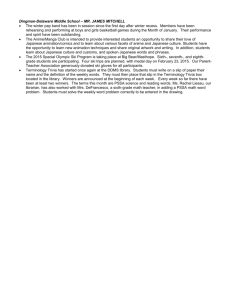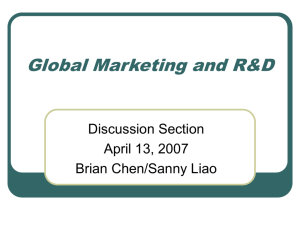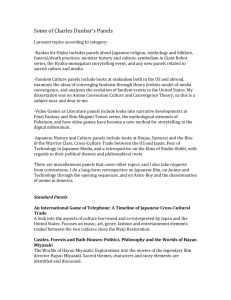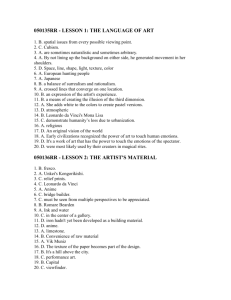Popular Nationalism
advertisement
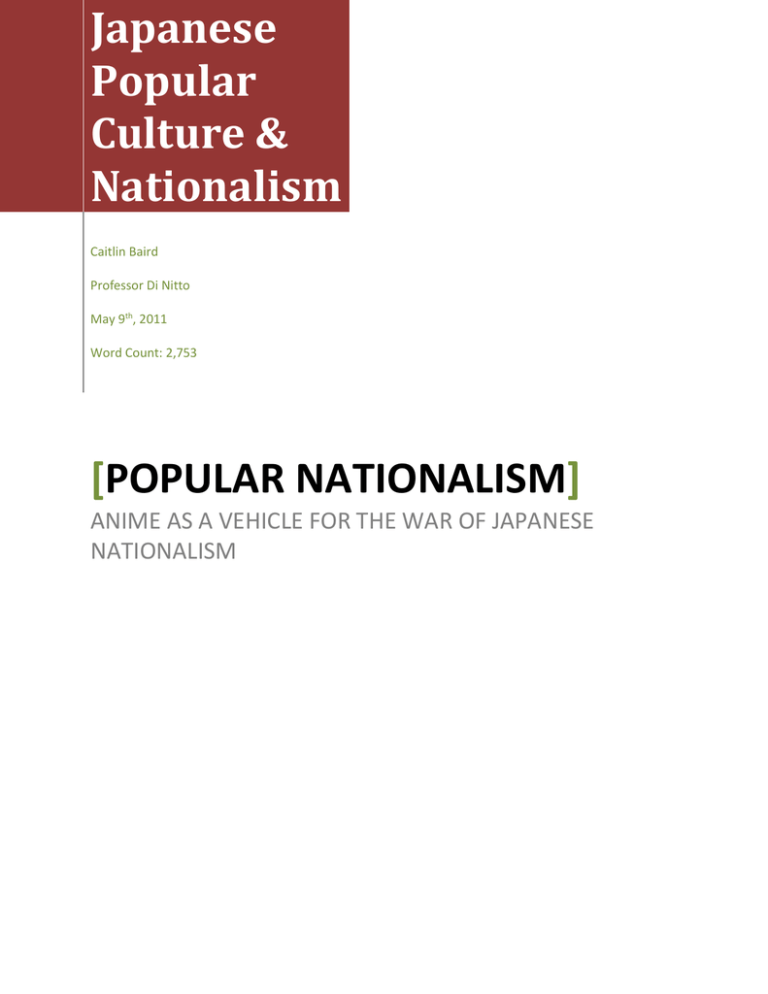
Japanese Popular Culture & Nationalism Caitlin Baird Professor Di Nitto May 9th, 2011 Word Count: 2,753 [POPULAR NATIONALISM] ANIME AS A VEHICLE FOR THE WAR OF JAPANESE NATIONALISM As the saying goes ‘art imitates life’ and in turn ‘life imitates art.’ The paradox of this insinuation is all the more truthful when art becomes the main vehicle of entertainment consumption in a consumerist nation, such as anime has become in Japan. Anime is the iconic art form of 21st Century Japan, and has saturated not only Japan itself but many other Asian and Western Nations. It has become synonymous with the Popular Culture Movement of Japan’s post-bubble world providing entertainment for all ages and demographics within Japanese society. At first glance it would appear that like other popular culture icons, anime is nothing more than another way for kids to ‘rot their brains.’ But like all effective art anime has a message deeply ingrained within its big round eyes and over-exaggerated story lines, and is becoming a battleground of nationalist ideals. For what better way is there to effectively communicate a nationalist agenda then through a medium used by nearly the entire population? At a certain point during the late 60s as the first anime series were beginning under the guidance of the “Father of Japanese Animation” Osamu Tezuka,1 animators and manga artists began to understand how powerful their art form could be. They discovered that by placing certain imagery within their storylines and characters that was familiar and accessible to the masses, they could ultimately begin to influence the mindset of the people. This technique is a well-known one most commonly used by military institutions as propaganda during times of war, but in its new form of anime it takes on a frightening persuasiveness especially in the hands of its younger and adolescent viewers. To them anime is like a friend they have grown up with, a form of truth free from the influence of the government and the media, something 1 Fred Patten. “A Capsule History of Anime.” Animation Magazine. California: 1996. Pg. 3 1|Page that is understandable and offers a sense of belonging. In this way anime has become a vehicle for the war of Japanese nationalism, with liberal and conservative views vying for the support of the Japanese people. The conservative side of this battle draws from the foundations of traditional Japanese nationalism, with an emphasis on militarism in the name of self-defence and glorifying Japanese history and traditional morals. In the political arena these views have taken the form of Constitution revision, textbook revision, and redefining the purpose of the Self-Defence forces.2 Conservative views seek to encourage national nationalism, in the sense that Japanese people will become unrelenting supporters of Japan in all its endeavours and support policies from such parties as the LDP to revise the Constitution in areas concerning military and education. By the late 90s and early 00s conservative manga was receiving extensive media coverage, in particular Kobayashi’s Sensoron and Akiyama’s Chugoku Nyumon, identifying the effect this form of popular nationalism was having on the Japanese populace. Little focus however, was given to the more subtle forms of conservative imagery that had been and continue to be present in mainstream anime. The liberal side of the battle calls on the Japanese people to become responsible individuals, and is in actual fact more a battle of defending current societal trends than trying to affect change. Liberal anime itself is far younger than conservative examples, and is far less subtle. Imagery alluding to individual freedom, consumerism, environmental concerns, and anti-colonial sentiment are the more common liberal sentiments found in mainstream anime, and even encourage the consumption of the medium that they are found in. These liberal 2 Hinoyori Sasada. “Youth & Nationalism in Japan.” SAIS Review. (26.2) 2006: 109 - 122 2|Page ideals are aimed at continuing the current trend in Japanese government policy, as well as defend many of the concerns that arose during the 90s that caused many Japanese and international voices to question the moral integrity of the nation. In terms of conservative imagery found in anime, no series is more well-known than Sailor Moon created by Naoko Takeuchi as an adaptation from her manga series. Sailor Moon tells the story of an ordinary Japanese girl who is thrust into an age-old battle between good and evil. Although the main character Usagi is reluctant at first to transform into Sailor Moon and fight-off the minions of evil, with the help of her friends she finds the courage to defend the innocent and vanquish the enemy time after time. This story rings with the same tone as another historical Japanese document known as the “Imperial Rescript on Education” which states; “…should emergency arise, offer yourselves courageously to the State; and thus guard and maintain the prosperity of Our Imperial Throne coeval with heaven and earth.”3 In many anime which feature ordinary citizens rising to defend against aggression, the imagery of sacrificing ones-self for the protection of the State is clearly evident. This feature also occurs in many Western comics as well, but in its anime form Usagi shows a clear apprehension at being Sailor Moon, but sacrifices herself and her ordinary life in order to save her people and her planet. This is exemplified in the last episode of the series when Sailor Moon proclaims; “I’ll never give up, because I believe in this world I love, this world that everyone tried to protect…”4 By teaching young viewers that a true ‘hero’ is willing to defend their ‘world’ by sacrificing themselves, you are forming a new force to push for a revision of Article 9 of the constitution that would allow citizens to rise up to defend their State. 3 4 Imperial Rescript on Education of the Emperor Meiji. (Japan: Oct. 30th,1890). Sailor Moon. By Naoko Takeuchi. Toei Animation, 1992. Season 5, Episode 200, Part 3. 3|Page Another notable image found in Sailor Moon is the uniforms worn by the characters as their school uniforms as well as in their transformations. Japanese school uniforms in their design are based on the naval uniforms of Japanese soldiers worn during World War II, and were meant as a sentiment of unification and equality.5 At their point of inception the Japanese government was also inclined to eliminate the increasingly apparent Western-style clothing flooding Japan during the 1920s, and in turn the school uniforms became a visual reminder of Japan’s own traditions and especially its military traditions.6 The sailor aspects of the school uniform portrayed in Sailor Moon are most apparent in the blue collars and tied ascot around the neck (See Appendix A). Then when they transform into Sailor Scouts the sailor-style uniform becomes even more pronounced as the skirts become shorter, and boots and gloves are added making the look more aggressive and sexualized (See Appendix B). Including the fact that these characters are known as Sailor Scouts and the show is called Sailor Moon, the characters in the show are fulfilling the purpose of Japanese school uniforms in that they have become a visual reminder of Japanese militarism. Adding this imagery to the selfless heroism portrayed by the character’s actions the visual reminder becomes positive and thus the sailor uniform image becomes subconsciously positive as well, creating a glorification of Japan’s militaristic history. One final point of conservative imagery found in this series is the character symbolism of the main character Usagi/Sailor Moon. In this storyline Usagi is in fact the Moon Princess and is the embodiment of light and goodness. This characterization and depiction in the anime 5 Sharon Kinsella. “What’s Behind the Fetishism of Japanese School Uniforms?” Fashion Theory (Volume 6, Issue 2) United Kingdom: 2002. 217-218 6 Ibid. 218 4|Page shows a resemblance to the sun goddess Amaterasu from Japanese folk lore, who was born in Japan and spread her rays of light to all the other nations of the world.7 This folk tale is very important in the fact that it became a central point in Japanese-centric views most apparent during the war years, and was used as justification for Japanese colonization as Japan was the superior nation because it was the birthplace of Amaterasu. Amaterasu was the ancestor of the Imperial family and a source of light and warmth,8 and in her reflection Usagi becomes the Queen of the Moon Kingdom and is often portrayed with rays of light radiating from her in times of great ascendance (See Appendix C). By comparing the main character to the sun goddess Amaterasu and the ideology that accompanies her, Sailor Moon shows further proof of how traditional conservative views are becoming a part of mainstream anime. On the opposite end of the spectrum the anime series Super Gals! is a strong case for liberal nationalist imagery. As mentioned before, the liberal imagery portrayed in Super Gals! is anything other than subtle. The story revolves around the main character Kotobuki Ran and her friends as they navigate and revel in the world of Kogal culture found in the Shibuya district in Tokyo. Ran typifies the Kogal fashion through her school uniform with her skirt shortened to a miniskirt by rolling up the waistband to shorten the hem, her loose or baggy socks that require special sock glue to keep them up,9 and her obsession with attaining a school bag from the Meisho Daichi High School boys. Her appearance is also very typical of the Kogal culture with a red streak in her bleached hair, long manicured nails, lots of jewellery, and sizable quantities of make-up making her the top Kogal in Shibuya (See Appendix D). 7 Matsumae Takeshi. Asian Folklore Studies. (Japan: Nanzan Institute for Religion and Culture, 1978). 3 Ibid. 9 Sharon Kinsella. “What’s Behind the Fetishism of Japanese School Uniforms?” Fashion Theory (Volume 6, Issue 2) United Kingdom: 2002. 230 8 5|Page In Japanese society, especially in the media, this appearance would be seen as a marker for a degenerate girl who partakes in scandalous behavior and is a prime example of the decay of Japanese morals. However, in the anime Super Gals!, Ran is seen as a role model to the girls of her school and it is her rebellious nature and sense of independence that ultimately saves her friends and others from the dangers of ‘perverted old men’ and conflicts. Liberal idealism has taken the rebellious nature of the Kogal culture and turned it into a righteous force that is willing to stand against the moral decay of society, instead of being the cause of it. The liberal agenda has always supported the freedoms the new Constitution afforded the populace when it was enacted in 1947, and by illustrating a positive outcome of Japanese citizens using this freedom to protect their fellow citizens and upholding Japanese social morals they are in turn defending the Constitution from revision. Super Gals! also touches on the subject of Kogals in relation to compensated dating in the first episode. Aya, Ran’s classmate and soon-to-be close friend, is the smartest girl in the school with incredible work ethic and a loyal disposition. However, like many teenagers in Japanese society, she is severely pressured by her parents to achieve good grades and thus never let her go out. In rebellion Aya becomes involved in the world of dating older men for cash, enjo kosai, until she is caught by Ran who confronts her and forces her to realize she has so much more potential and invites her into her circle of friends. Compensated dating has received a lot of media attention currently, and many conservative factions have blamed the abundance of freedoms afforded by the Constitution for actions of these high school girls.10 However, the liberal sentiment in this anime series turns the blame towards the broken family 10 Leheny, David. Think Global, Fear Local. (America: Cornell University Press, 2006). 74. 6|Page unit and the educational system that places too much pressure on young students.11 Not only do they reject the proposal of conservatives but they also provide a heroine in the form of a Kogal, further insinuating that independence leads to a form of unity within the Japanese populace to protect one another as well as the moral integrity of the State. The media is the other great opponent liberalists face and attempt to combat in their liberal imagery present in Super Gals!. Most publicized by the media is the sexual promiscuity of Kogals, and the media itself has been accused of over exaggerating the actuality of the situation.12 Not to say that compensated dates don’t occur, only that the media gives more importance to a rare occurrence. Super Gals! attempts to combat this image through its characters’ development in the course of their relationships. Most importantly the girls only participate in monotonous relationships; they are not promiscuous and are only intimate with their boyfriends. The intimacy in these relationships is also very tame with no visuals of physical affection, and throughout most of the series the couples never share their first kiss. Relationships portrayed in this anime are wholesome and based on supporting one another through good times and bad. Even in the epilogue of the anime all the couples stay together and end up getting married. The importance of this imagery is the liberal intention not only to combat media slandering, but also social critics who blame independent women for the decreasing population. Super Gals! promotes an image of the Kogals as independent girls who are free to express themselves, but are still moral and responsible. Imagery is a powerful resource, and a medium that utilizes images to such an extent as anime does can have a profound effect on the populace. What makes imagery more influential 11 12 Tomiko Yoda. “A Roadmap to Millennial Japan.” The South Atlentic Quarterly (Volume 99.4) America: 2000. 658. Leheny, David. Think Global, Fear Local. (America: Cornell University Press, 2006). 3. 7|Page than words simply written in a textbook for example is that they serve as visual triggers when the audience returns to the real world.13 After viewing Sailor Moon for example, a child who has grown up watching this anime series will see their school uniform as a symbol of unity and distinct Japanese culture and will favour it above western-style clothing. They will also be more inclined towards policies that are presented as a protective legislator for the State and are more traditionally Japanese, as they have been taught to think in terms of protecting their fellow Japanese citizens at their own sacrifice and will most likely become supportive of the Self-Defence Forces. However, for those children who have grown up watching an anime series such as Super Gals!, their approach to life will be more individually focused. Some may follow the example of the glorified Kogal presented in the anime, but all will be more sympathetic towards the Kogal culture and are unlikely to hold current Japanese societal traditions responsible for supposed moral decay. Through these two series we are able to see how anime has become a vehicle for nationalism and a battleground between conservative and liberal ideologies. With Japanese viewers watching on average 17.9 hours a week of television,14 with half the population estimated to watch at least one anime series,15 this medium has become a powerful avenue to promote political preferences on some of the most pressing issues in current Japanese society. When political issues are removed from their original context and applied to a more accessible situation, such as those provided by anime, the public becomes more engaged but at the same 13 Messaris, Paul. Visual Persuasion. (America: SAGE Publications, 1997). 3. “Average number of hours per week spent watching television,” Sign On San Diego. The Economist World in Figures. http://www.signonsandiego.com/uniontrib/20051227/news_lz1n27list.html. Accessed Apr 27, 2011. 15 “Online Survey Reveals Half of Japanese Watch TV Anime,” My Anime List. DoHouse Research Company. http://myanimelist.net/forum/?topicid=191889. Accessed Apr 27, 2011. 14 8|Page time more bias towards a particular view. Anime cannot be dualistic and show two sides of the same story, because the author or animator in charge has to give each story a firm moral or the entertainment of the show is lost to political correctness. Whether it is right or wrong is a decision for the public. For older viewers this battle of ideologies is less threatening to their developed minds, but to younger viewers, who are placed in front of the TV as a form of babysitting, these ideologies develop into a mindset. In all, anime has become an effective mode of nationalist expression in the form of popular culture, lending itself to the title of popular nationalism. As the world develops and new technologies arise, political factions are going to develop new ways to influence the public to serve their purpose, and in 21 st Century Japan that development is imagery within anime. 9|Page Bibliography Animation Sailor Moon. By Naoko Takeuchi. Toei Animation, 1992. Season 5, Episode 200. Articles Fred Patten. “A Capsule History of Anime.” Animation Magazine. California: 1996. Hinoyori Sasada. “Youth & Nationalism in Japan.” SAIS Review. (26.2) 2006. Sharon Kinsella. “What’s Behind the Fetishism of Japanese School Uniforms?” Fashion Theory (Volume 6, Issue 2) United Kingdom: 2002. Tomiko Yoda. “A Roadmap to Millennial Japan.” The South Atlentic Quarterly (Volume 99.4) America: 2000. Books David Leheny. Think Global, Fear Local. (America: Cornell University Press, 2006). Matsumae Takeshi. Asian Folklore Studies. (Japan: Nanzan Institute for Religion and Culture, 1978. Paul Messaris. Visual Persuasion. (America: SAGE Publications, 1997). Documents Imperial Rescript on Education of the Emperor Meiji. (Japan: Oct. 30th,1890). Internet Sources “Average number of hours per week spent watching television,” Sign On San Diego. The Economist World in Figures. http://www.signonsandiego.com/uniontrib/20051227/news_lz1n27list.html. Accessed Apr 27, 2011. 10 | P a g e “Online Survey Reveals Half of Japanese Watch TV Anime,” My Anime List. DoHouse Research Company. http://myanimelist.net/forum/?topicid=191889. Accessed Apr 27, 2011. Appendix Appendix A Naoko Takeuchi, Sailor Moon. Toei Animation. Appendix B Naoko Takeuchi, Sailor Moon. Toei Animation. Appendix C Naoko Takeuchi, Sailor Moon. Toei Animation. Appendix D Mihona Fujii, Super Gals. Studio Pierrot. 11 | P a g e CHECKLIST Make sure to review the following checklist. If any of the following are not done or are done incorrectly, you automatically lose 5 points (1/2 of a letter grade) on your paper. You must turn this in with your paper or it will not be graded. Name: Caitlin Baird Class: Japanese Popular Culture & Nationalism Assignment: Final Paper Spell check Page numbers Name on first page only Main text is 12 point font, double-spaced, no additional return between paragraphs Footnote/endnote text single-spaced, 10 point font Paper title, only necessary on first page, all initial caps Commas inside quotation marks. Periods inside quotation marks if terminal. Colon & semicolon outside quotation marks; exclamation point and question mark outside quotation marks unless terminal and apply to whole sentence. Book and film titles italicized or underlined (choose one) Short stories and articles in quotations Foreign words not found in an English dictionary are italicized Quotes over 5 lines indented as block quotes, single-spaced, no quotation marks All sources used are properly cited with respective page numbers Bibliography if required Citation style (list the style you are using): MLA 12 | P a g e
